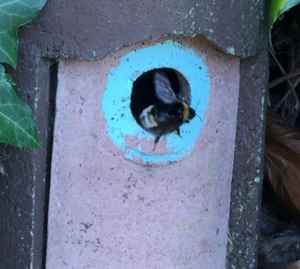The Gladiator bumblebee, Bombus vestalis, is a cuckoo bumblebee
Yes we have all heard of cuckoo birds. Cuckoos and their rather anti social behaviour are known to many people. But did you know there are species of bees and wasps that are also cuckoos? Queen bumblebees emerging after hibernation may have to fight to the death with other queen bumblebees in their search for a suitable nest site. The victor we shall call the foundress queen, who then sets about establishing her colony. There are other female bumblebees who specialise in seeking out already established nests, these are the cuckoo bumblebees called Psithyrus.
Gladiator bumblebees
These females are born fighters, with their tougher, thicker body armour, which is not as flexible as their hosts, (less chance of being stung in a weak spot). They are equipped with stronger jaws and stings which have a larger venom sac than do true queen or worker bumblebees. They are not equipped with pollen baskets, something I saw many years ago with a large bumblebee literally covered in pollen all over her body. She made no attempt to comb it or move it to her pollen baskets. I thought this was rather strange. She sat sunning herself for quite some time. It was only later I found out about cuckoo bumblebees. They have less hairs on their body to aid in collecting pollen and are unable to secrete wax to make wax cells. There are no workers who go out to forage for their siblings, none that participate intending the nest as do true worker bumblebees. They are simply not equipped to establish their own nests. The cuckoo bumblebees are wholly dependent on other bumblebees species. They are born to invade another bumblebees nests and fight for it. Truly a Gladiator bee!
Conquer or kill the host
Instead they seek out, by scent, find and kill foundress queens, along with any workers that attack her in defence of their nest. Then she will take over the nest, enslave the conquered workers to feed, tend and nurse her own young, all of whom are either males or females. These females are not foundress queens in the strictest meaning of queen bumblebees.
This B. vestalis resembles its host. B.terrestris. A B. terrestris queen had visited this box several times over the course of a few days. I suspect there was enough of the visiting queen’s scent to attract the B. vestalis. I saw a B. vestalis on a few days visiting the nest box, by flying straight inside and waiting at the entrance as seen, indicating she knew exactly where it was. This behaviour leads me to suspect it was the same individual. You can tell the buzz of a B. vestalis as it is a much more deeper hum-like sound than a true queen bumblebee buzz. Wait till you hear this in slow motion!
Read about the B. vestalis that failed to breach my bumblebee cat flap!
Refs: Besides my own experiences and observations;
Alford, D V (2009) ” The life of the bumblebee”, Northern Bee Books, Hebden Bridge, West Yorks, which has a fascinating account of this cuckoo bumblebee and how timing and strategy is critical to her success.
Interested in Citizen Science and pollinators? See The Buzz Club.
You may find this paper interesting about the role of scents used by cuckoo Psithyrus bumblebees


Recent Comments